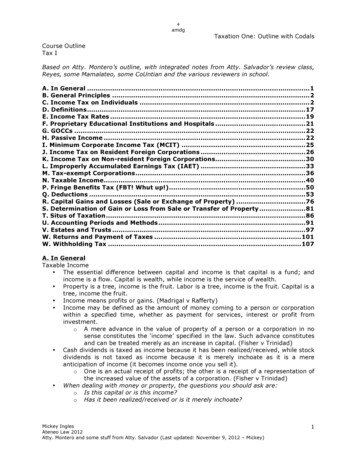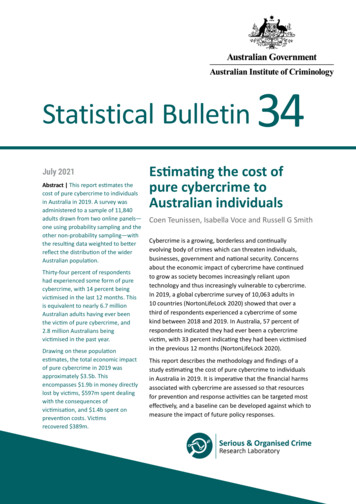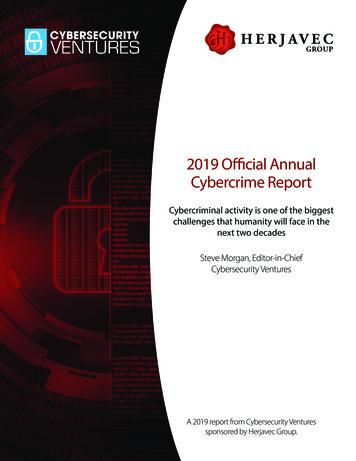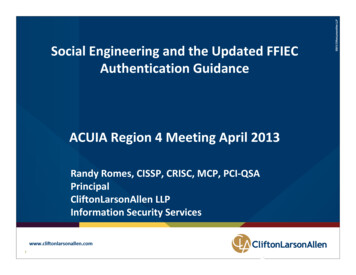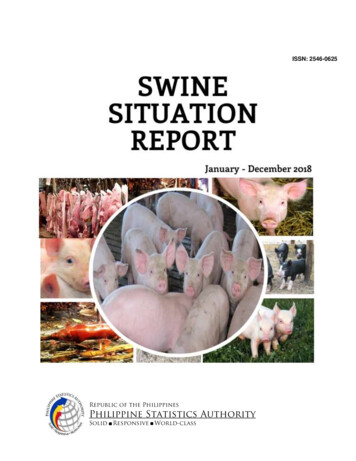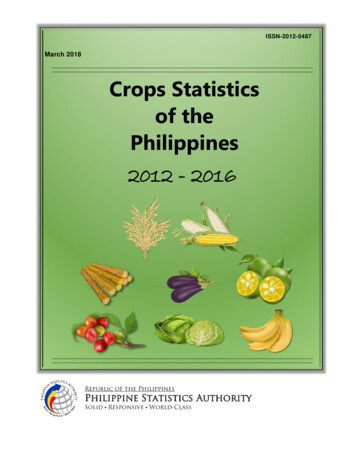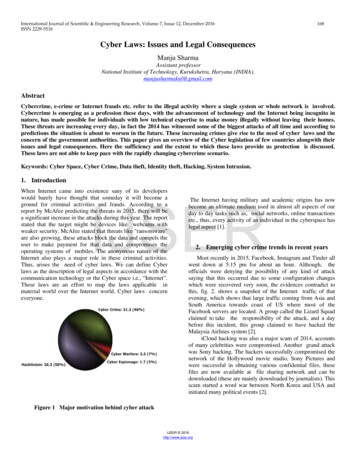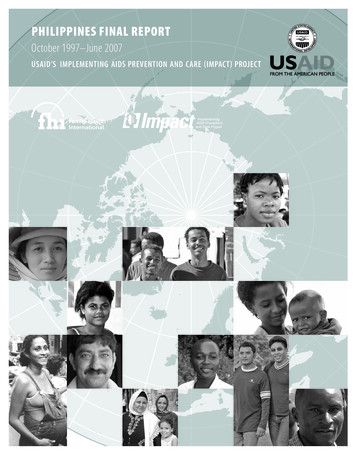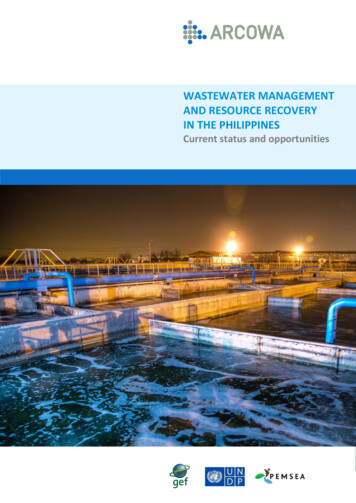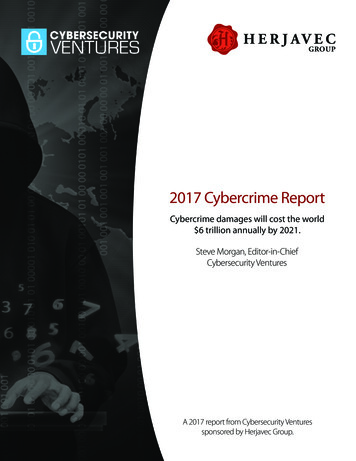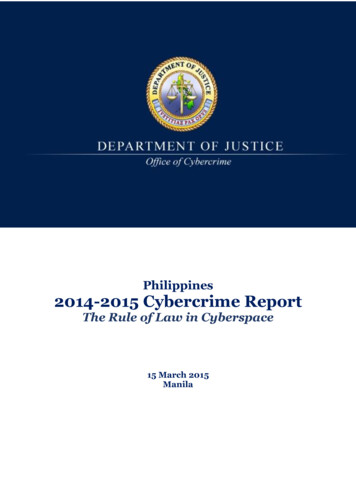
Transcription
Philippines2014-2015 Cybercrime ReportThe Rule of Law in Cyberspace15 March 2015ManilaDepartment of Justice
The VisionA just and peaceful society anchored on the principles of transparency,accountability, fairness and truth.The MissionTowards the effective, efficient and equitable administration of justice.2
Table of ContentsMessages . 1About the Department of Justice – Office of Cybercrime . 2Structure . 3Cybercrime Desk . 4Prosecution Task Force on Cybercrime . 3Legal Framework . 6Cybercrime Prevention Act of 2012 . 6Rules on Electronic Evidence . 6Data Privacy Act of 2012 . 6Anti-Child Pornography Act of 2012 . 6Current Trends and Challenges . 4Offenses against and by means of computer system . 5Challenges on Electronic Evidence. 6Authorities under the Cybercrime Prevention Act of 2012 . 6Cybercrime Investigation and Coordinating Center . 6Department of Justice – Office of Cybercrime . 6National Bureau of Investigation – Cybercrime Division . 6Philippine National Police – Anti-Cybercrime Group . 6Cybercrime Investigation Flowchart . 6Priorities . 6Operational Achievements . 6Future Plans and Programs . 63
Message from Secretary of Justice Leila M. De LimaGreetings!It is my honor and privilege to present the DOJ Office ofCybercrime‟s 2014 Annual Report which details the accomplishmentsin providing special protection to the public by implementing ourcybercrime and cyber-related laws, particularly the CybercrimePrevention Act of 2012 which is geared for the prevention,investigation, interdiction and prosecution of cybercrime cases.Since the passage of Republic Act No. 10175, the Department hastaken arduous steps in strengthening the government‟s capability toimplement and enforce the law in order to fight cybercrime in thecountry. This report outlines not only the milestones of what theDepartment has achieved but also emphasizes the continuing effortsand expected outputs sought to be attained.I thank all the men and women who constituted the technicalworking group that crafted the implementing rules and regulations ofthe cybercrime law, including all stakeholders – private and publicsectors who participated in the public consultations and provided vitalinputs, comments, and suggestions.I also thank our law enforcement authorities, the National Bureauof Investigation Cybercrime Division and the Philippine NationalPolice Anti-Cybercrime Group, who are more than ever vigilant andresponsible in protecting our citizenry against cybercrime.As the government‟s principal law agency, the Department vows togive more protection to those who are more vulnerable in our society.I speak of our Filipino children who are ever more acquainted withmodern technology, especially in the internet. It is more important thatwe protect our children against online child abuse and punish thosewho are treacherously doing harm using anonymity in cyberspace.In the current pursuit in fighting cybercrime, it is also thecontinuing directive for the Office of Cybercrime to provide capacitybuilding trainings to our law enforcement authorities, prosecutors,4
state counsels, public attorneys, judges, and other governmentagencies.Further, we anticipate the designation of special cybercrime courts,and also our country‟s accession to the Convention on Cybercrime ofthe Council of Europe.Finally, it is the responsibility of the Department to prioritize thefight against online child abuse, internet fraud and network security.Thus, we call on all government agencies, the ICT industry, and theprivate sector to unite and be one in the fight against cybercrime.Mabuhay at maraming salamat po!5
Message from Assistant Secretary Geronimo L. Sy - Head, Officeof Cybercrime2014 is a year of significant progress for the implementation of theCybercrime Law. It is a great pleasure to present the 2014 AnnualCybercrime Report and highlight the performance of the Departmentin carrying out its vision of having a sound, safe, and securecyberspace.Though the Cybercrime Law was challenged on constitutionalgrounds, the Supreme Court upheld its validity on 18 February 2014which paved the way for further action to disseminate information onits implementation.As stated in the Report, the Office of Cybercrime (OOC)spearheaded the formulation of the implementing rules and regulations(IRR) and conducted series of meetings and public consultations withstakeholders, industry partners, and concerned government agencies.The envisioned result is a skillful execution of investigating andprosecuting cybercrimes.Concrete accomplishments included trainings and workshopsfocused on investigations on cybercrimes, handling and analyzingelectronic and digital evidence, and cyber incident response, whichwere attended by judges, law enforcers and other personnel.Also worth noting is our partnership with foreign agencies and ourlocal law enforcement agencies, which led to the arrest andprosecution of violators of RA 9208, RA 7610, Article 201 of theRevised Penal Code (RPC) and RA 9775.As we pursue our mission to suppress cybercrime, we are confidentthat the strategic direction we have chosen is sound as we recognizethe need to continue training our law enforcement agencies oncomputer forensics which is an important part of cybercrimeinvestigations. Indeed, providing them with structured procedures andguidelines consistent with international best practices that willstrengthen the protection of the citizenry against cybercrime.6
We made considerable progress in 2014, but there is much to bedone to institutionalize our fight against cybercrime.I wish to thank the dedicated efforts of everyone who are involvedin the implementation of the Cybercrime Law. I hope that thecontinued support from various agencies will further improve ourperformance and enable us to reach our targets for the coming years.Thank you.7
I.About the Office of Cybercrime (OOC)Section 23 of Republic Act (R.A.) No. 10175 or the CybercrimePrevention Act of 2012 provides for the creation of an Office ofCybercrime (OOC) within the Department of Justice (DOJ) and isdesignated as the central authority in all matters related tointernational mutual assistance and extradition for cybercrimematters1.The institution of central authorities is a common feature ofmodern instruments dealing with mutual assistance in criminalmatters, and it is particularly helpful in ensuring the kind of rapidreaction that is so useful in combating computer or computer-relatedcrime.Primarily, direct transmission between such authorities isspeedier and more efficient than transmission through diplomaticchannels. In addition, the establishment of an active central authorityserves an important function in ensuring that both incoming andoutgoing requests are diligently pursued, that advice is provided toforeign law enforcement partners on how best to satisfy legalrequirements in the requested Party, and that particularly urgent orsensitive request are dealt with properly.In this regard, to ensure that the technical nature of cybercrimeand its prevention is given focus, Section 11 of R.A. No. 10175specifically mandates the National Bureau of Investigation –Cybercrime Division and the Philippine National Police – AntiCybercrime Group (ACG) to submit timely and regular reportsincluding pre-operation, post-operation, and investigation results andsuch other documents as may be required, to the DOJ-OOC formonitoring and review2.To meet the standard of the Council of Europe‟s Convention onCybercrime which calls for a single „central authority,‟ the duties andresponsibilities of the DOJ-OOC as provided in the rules andregulations that implements R.A. 10175 are the following:12Section 23, R.A. 10175Section 11, Ibid.8
a. To act as a competent authority for all requests for assistancefor investigation or proceedings concerning cybercrimes,facilitate the provisions of legal or technical advice,preservation and production of data, collection of evidence,giving legal information and locating suspects;b. To act on complaints/referrals, to cause the investigation andprosecution of cybercrimes and other violations of the Act;c. To issue preservation orders addressed to service providers;d. To administer oath, issue subpoena and summon witnesses toappear in an investigation or proceedings for cybercrime;e. To require the submission of timely and regular reportsincluding pre-operation, post-operation and investigation resultsand such other documents from the PNP and NBI formonitoring and review;f. To monitor the compliance of the service providers with theprovisions of Chapter IV of the Act, and Rules 7 and 8;g. To facilitate international cooperation with other lawenforcement agencies on intelligence, investigations, trainingand capacity building related to cybercrime prevention,suppression and prosecution;h. To issue and promulgate guidelines, advisories, and proceduresin all matters related to cybercrime investigation, forensicevidence recovery, and forensic data analysis consistent withindustry standard practices;i. To prescribe forms and templates including but not limited topreservation orders, chain of custody, consent to search, consentto assume account/online identity, request for computer forensicexamination; andj. To undertake the specific roles and responsibilities of the DOJrelated to cybercrime under the Implementing Rules andRegulation of Republic Act No. 9775 or the Anti-ChildPornography Act of 2009;k. To perform such other acts necessary for the implementation ofthe Act.9
OOC StructureAssistant Secretary / OOC HeadOffice of the DirectorInvestigation andOperations DivisionInvestigation andDigital ForensicsEnforcementand Data CenterDivisionLegal DivisionTraining,Research andDevelopmentCybercrime Desk for MLAT-EXTRATFor immediate attention that is essential for the effectiveimplementation and enforcement of the Cybercrime Prevention Act of2012, Department Order No. 814 established the Cybercrime Desk – atask force that handles Mutual Legal Assistance and Extraditionrequest was constituted which is comprised of State Counsels from theOffice of the Chief State Counsel and Office of Cybercrime.Chief State Counsel Ricardo V. Paras III and AssistantSecretary Geronimo L. Sy serves as the Chair and Vice-Chair,respectively, and five State Counsels complete the Desk.Assistance and support that may be required by the CybercrimeDesk will be provided by the Office of Cybercrime, in considerationof the technical nature which will accompany requests for cooperationto and from this jurisdiction.10
Prosecution Task Force on CybercrimeThe National Prosecution Service - Prosecution Task Force onCybercrime was constituted in the DOJ central office to handle highprofile and sensational cases. Said Task Force is chaired by SeniorDeputy State Prosecutor Theodore M. Villanueva and vice-chaired bySenior Assistant State Prosecutor Lilian Doris S. Alejo.The Cybercrime Prosecution Task Force in the National CapitalRegion Prosecution Offices was also established which will handlecybercrime and cybercrime related cases within their respectivejurisdiction which are punishable under the following laws:a.b.c.d.e.f.RA 10175 – Cybercrime Prevention Act of 2012RA 9995 – Anti-Photo and Voyeurism Act of 2009RA 9775 – Anti-Child Pornography Act of 2009RA 8792 – E-Commerce Act of 2000RA 8484 – Access Devices Regulation Act of 1998RA 4200 – Anti-Wiretapping Law of 1965The OOC coordinates with law enforcement agencies and theforegoing Task Force to monitor cybercrime and cybercrime relatedcases for the effective implementation and enforcement of the saidlaws.II.Current Trends and ChallengesThere are around 177 Internet Service Providers (ISPs) in thecountry today with the major providers offering services at an averagerate of P25.00 per hour. Digital subscriber line (DSL), wireless and fixedbroadband, cable, satellite Internet facilities are now being offered to thepublic making access to the internet easily serviceable. The number ofPhilippine Internet users range to 33.6 million.3 Contributing heavily toits growth are Internet cafes that allow Filipinos who do not owncomputers to gain access to the facility at an affordable price. Anincreasing number of schools and small and medium enterprises (SMEs)accessing the Internet contributed to this growth as well.3PNP Cybersecurity, Research and Analysis Division Report (30 June 2012)11
The Philippines has been regarded as a haven of crime committedonline for many years while other countries have developed cyberwarfare. It has only begun its stand when the country received recognitionin 2000 as the source of “LOVE BUG” or the “I love you” virus. It hasbeen 13 years since the virus bolstered the insufficiency of thegovernment‟s policies on cybercrime suppression, investigation andprosecution when the author of the virus was released from jail and nocase was filed against him for lack of legislation defining the act as acrime and imposing penalty for such commission.On 12 September 2012, the Philippine Congress enacted theCybercrime Prevention Act to govern crimes committed in thecyberspace. The new law specifies several new acts of cybercrime.Among those prohibited under the law are cybersex, online childpornography, illegal access to computer systems or hacking, onlineidentity theft, and spamming. It increases the penalty for computerrelated crimes. However, the law could not take its course in attaining itsaim due to the indefinite restraining order issued by the Supreme Courtfor its implementation until the petitions challenging constitutionality ofthe law were resolved last February 2014.Offenses against and by means of computer systemCyberespionage attacks or intellectual property theft is consideredas the major threat that increasingly hits the manufacturing sectors as wellas small businesses with 42% surge during 2012 compared to 2011.Thirty one percent of these attacks are directed to small businesses thatare attractive targets. Consumers remain vulnerable to ransomware andmobile threats, particularly on the Android platform.From rank 35th in 2012, Philippines has moved to rank 39 amongcountries globally on internet threat activities, according to the annualSymantec Internet Security Threat Report (ISTR). According to thisyear‟s ISTR, the top growing trends that organizations in the countryshould watch out for in today‟s threat landscape includes advancedtargeted attacks, mobile threats, malware attacks and data breaches.Targeted attacks are growing, with the number of daily targeted attacksincreasing from 7 per day to 82 per day by the end of 2011.Targeted attacks use social engineering and customized malware togain unauthorized access to sensitive information. Meanwhile, the reportcited that the most frequent cause of data breaches that could facilitate12
identity theft or loss of a computer or other medium on which data isstored or transmitted, such as smartphone, USB key or backup device.From January to December of 2014, the Philippine National Police(PNP) – Anti-Cybercrime Group (ACG) recorded six hundred fourteen(614) cybercrime incidents, compared to 2013 where there were onlytwo-hundred and eighty-eight (288) incidents.Cybercrime 2013 vs SepOctNovDec 0536254654751614Distribution of Cybercrime for the year 2014RA 9995 (Anti-Photo andVoyeurism Act of 2009)11%Others5%RA 8792 (ElectronicCommerce Act of 2000)8%RA 9262 (Anti-Violenceagainst Women and theirChildren)1%Internet Fraud/ Scam22%RA 9208 (Trafficking inPersons Act of 2003)0%Illegal Online Gambling0%Credit Card Fraud1%RA 7610 Child Abuse Law1%ATM Fraud1%Sextortion/Referred Cases*7%Identity Theft9%RA 9775 (Anti-ChildPornography Act of 2009)1%Libel16%Harassment/ Threat10%RA 8484 (Access DevicesRegulation Act of 1998)4%13
Crimes against ChildrenThe online platforms of social engagement brings a number ofbenefits to children but it can also be a source of threat to their safety andprotection. Children use it as a tool for education thus making themprone to online predators usually disguised as “virtual friends” or “virtualmentors. Globally, sexual abuse and exploitation on children online isalarming, and in response to this, fifty four (54) countries around theworld have gathered in a Global Alliance against Child Sexual AbuseOnline and which was launched on 5 December 2012.The Philippines is a signatory to this global alliance and iscommitted to contribute to the meeting of the four (4) policy targets set,such as: Enhancing efforts to identify victims and ensuring that they receivethe necessary assistance, support and protection; Enhancing efforts to investigate cases of child sexual abuse onlineand to identify and prosecute offenders; Increasing awareness among children, parents, educators and thecommunity at large about the risks; and Reducing the availability of child pornography online and the revictimization of children.In compliance to the commitment to the Global Alliance, the DOJConvergence of Councils and Committees for Child Protection held asmall roundtable dialogue with relevant and critical public and privatestakeholders. The dialogue format is deemed to be a balanced and civilforum to stimulate dialogue and collaboration, to help build trust andtransparency among stakeholders, and to provide a venue to discuss areasof cooperation and partnerships to intensify the fight against alarmingincrease in the number of cases of abuse and exploitation of Filipinochildren online4.At present, the alarming issues of child pornography locally andglobally, citing a three hundred forty-five (345%) increase in childpornography sites from year 2001, and more than twenty thousand(20,000) child pornographic images on the internet every week. 2005 data4Convergence of Councils and Committees for Child Protection14
from computer and IT magazine Top Ten Reviews noted that childpornography is a three billion dollar ( 3 Billion) industry.5Challenges on Electronic EvidenceOn the advent of accessibility and affordability of internetconnection, communications have shifted peoples‟ medium ofinteractions. These interactions using electronic gadgets have spawnedlegal controversies as to the use of the electronic writings and itsadmissibility in court. With the ever-growing demand to regulatetransactions in the Internet, legislators enacted Republic Act No. 8792,otherwise known as the "E-Commerce Law". This law was subsequentlyfollowed by the issuance of the Supreme Court of A.M. No. 01-7-01-SC,otherwise known as the "Rules on Electronic Evidence".The admissibility of electronic evidence becomes a major issue ofthe citizens due to its unreliability and doubtful authenticity havinginternet technology involvement. Taking advantage of the complextechnology offered nowadays, electronic documents by all means couldbe changed and altered and used as evidence to prove allegations to thepoint of making false accusations and unjust judgment. Citizens, lawenforcement officers and judiciary‟s inability to understand thedivergence in technology will hamper the applicability and practicabilityof the Rules. Electronic documents without electronic signatures andproper authentication will have no credit on court cases. With such issuesand the continuing struggles of some people deprived of justice,electronic evidence could also be an avenue to enhance the divisionsbetween the rich and the poor.At present, the PNP-ACG Digital Forensics Laboratory recordedthat they were able to examine eight hundred fourteen (814) phones withnine hundred ninety-three (993) SIM cards, and three hundred forty-four(344) memory cards.5DSWD-ITMS15
Mobile Phone 3814Sim Card535968839212667150561325651993Memory Card212917313539254020412620344On the part of computer examined, PNP ACG received and examinedone hundred thirty two (132) Hard disk Drives and ten (10) laptops. Whilesixty-five (65) USB, fifty-two (52) CD, thirty-nine (39) DVD, seven (7) CCTVfootage, six (6) IPads and five (5) cameras were examined .Computer SepOctNovDec 16
CCTV footage, USB, DVD, CD, Camera and IPad OctNovDec 0002000206III. Legal FrameworkCybercrime cases in the Philippines cannot be completely andsuccessfully prosecuted under the existing laws of the Philippines like theRevised Penal Code, Access Device Regulation Act of 1998, ECommerce Act of 2000, Anti-Photo and Video Voyeurism Act of 2009,Intellectual Property Code of the Philippine, Consumers Act of thePhilippines, Special Protection of Children against Abuse, Exploitationand Discrimination Act, Anti-Trafficking in Persons of 2003 and AntiWire Tapping Law.Cybercrime Prevention Act of 2012The Philippines was invited to accede to the Budapest Conventionon 15 June 2011 without objection from member countries and annuallyinvited to join the Octopus Conferences. The Philippines substantiallyadopted the international definition of cybercrimes by the Council ofEurope and assisted the decision-maker to uphold the same by enacting acybercrime law.17
On 12 September 2012, the Philippine Congress enacted RepublicAct (R.A.) No. 10175 or “Cybercrime Prevention Act of 2012” whichcompletely addresses crimes committed against and by means ofcomputer system. The law focuses on the pre-emption, prevention andprosecution of cybercrimes such as offenses against the confidentiality,integrity and availability of computer data and systems, computer-relatedoffenses, and content-related offenses.The law provides procedural measures to be undertaken by lawenforcement authorities mandated by the law to enforce and implementits provisions. To ensure that the technical nature of cybercrime and itsprevention is given focus and the procedures involved for internationalcooperation considered, law enforcement authorities specifically thecomputer or technology crime divisions responsible for the investigationof cybercrimes are required to submit timely and regular reports includingpre-operation, post-operation and investigation results and such otherdocuments as may be required to the Department of Justice (DOJ) forreview and monitoring.Rules on Electronic EvidenceThe Philippine Supreme Court issued and adopted the Rule onElectronic Evidence or A.M. No. 01-7-01-SC pursuant to its rule-makingpower and consistent with Republic Act No. 8792 or the “E-CommerceAct of 2000” which gives credence to admissibility of evidence inelectronic form and to secure legal framework and environment forelectronic commerce. The Rule took effect on 1 August 2001 which wasinitially applicable only to all civil actions and proceedings, as well asquasi-judicial and administrative cases and amended to include criminalcases on 12 October 2002.The E-Commerce Act of 2000 is basically patterned from UnitedNations Commission on International Trade Law Model Law onElectronic Commerce to maintain uniformity and harmony with the othermember-states of the United Nations. The salient features of the Act areas follows:1. Provision on legal recognition of electronic documents or datamessages, electronic signatures, and electronic contracts;2. Require all government agencies to, among others, transactgovernment business and perform government functions using18
electronic data messages or electronic documents within two (2) yearsfrom the date of effectivity of the Act;3. Require the government to install an electronic network known as theRP Web within two years (2) years from the date of effectivity of theAct; and4. Penalize the offenses of hacking, cracking and piracy.Data Privacy ActOn 15 August 2012, Republic Act No. 10173 or the Data PrivacyAct of 2012 was enacted which was significantly influenced by Directive95/46/EC of the European Union and the Asia Pacific EconomicCooperation Information Privacy Framework. The introduction of the Actfollows a series of developments in the expansion of data privacy laws inthe Asia Pacific region and adds to an increasingly complex data privacyenvironment, particularly for organizations using business processoutsourcing services based in the region. The salient features of the Actare as follows:1. Require all personal information controllers to comply with a raft ofrequirements before any collection, holding, processing or use of thepersonal information takes place;2. Secure personal information handled by employees of BPO companiesbased in the Philippines;3. Attract more investors in the information and communicationtechnology and BPO industry in the Philippines; and4. Impose stronger sanctions on offenders.The Act also created the National Privacy Commission (NPC), anindependent privacy regulator, to administer and implement the Act. It isan agency attached to the Department of Information andCommunications Technology and headed by a Privacy Commissioner.The NPC will be responsible for the enforcement and administration ofthe Act. The NPC's powers include handling privacy-related complaints,conducting investigations, issuing orders for compliance and issuingtemporary or permanent bans on data processing by named Controllers.Anti-Child Pornography ActIn order to guarantee the fundamental rights of every child from allforms of neglect, cruelty and other conditions prejudicial to his19
development, the Philippine Congress enacted Republic Act No. 9775 orthe "Anti-Child Pornography Act of 2009”. The Act declares thefollowing acts unlawful:(a) To hire, employ, use, persuade, induce or coerce a child to perform inthe creation or production of any form of child pornography;(b) To produce, direct, manufacture or create any form of childpornography;(c) To publish offer, transmit, sell, distribute, broadcast, advertise,promote, export or import any form of child pornography;(d) To possess any form of child pornography with the intent to sell,distribute, publish, or broadcast: Provided. That possession of three(3) or more articles of child pornography of the same form shall beprima facie evidence of the intent to sell, distribute, publish orbroadcast;(e) To knowingly, willfully and intentionally provide a venue for thecommission of prohibited acts such as, but not limited to, dens,private rooms, cubicles, cinemas, houses or in establishmentspurporting to be a legitimate business;(f) For film distributors, theaters and telecommunication companies, bythemselves or in cooperation with other entities, to distribute anyform of child pornography;(g) For a parent, legal guardian or person having custody or control of achild to knowingly permit the child to engage, participate or assist inany form of child pornography;(h) To engage in the luring or grooming of a child;(i) To engage in pandering of any form of child pornography;(j) To willfully access any form of child pornography;(k) To conspire to commit any of the prohibited acts stated in this section.Conspiracy to commit any form of child pornography shall becommitted when two (2) or more persons come to an agreementconcerning the commission of any of the said prohibited acts anddecide to commit it; and(l) To possess any form of child pornography.The Act defines and punishes syndicated child pornography. It alsorequires Internet Service Provider (ISP) to notify the Philippine NationalPolice (PNP) or the National Bureau of Investigation (NBI) within seven(7) days from obtaining facts and circumstances that an
cybercrime and cyber-related laws, particularly the Cybercrime Prevention Act of 2012 which is geared for the prevention, investigation, interdiction and prosecution of cybercrime cases. Since the passage of Republic Act No. 10175, the Department has taken arduous steps in strengthening the government‟s capability to
